"Science is the only self-correcting human institution, but it also is a process that progresses only by showing itself to be wrong." -Allan Sandage
As April leaves us and May commences here at Starts With A Bang, I'm so pleased to inform you that amazing things are happening! Thanks to the support of everyone on Patreon, we're over 95% of the way towards our next goal: the creation of the most accurate, beautiful, scientific timeline of the Universe's history poster ever made! We've also covered the following topics this past week for you to ring in on:
- Could an atmosphere slow down a runaway spaceship? (for Ask Ethan),
- The incredible rings of Jupiter, Uranus and Neptune (for Mostly Mute Monday),
- What is the strongest force in the Universe?,
- This laser system foreshadows a new era in ground-based astronomy,
- Why does gravity move at the speed of light?, and
- How do we know the age of the Universe?
Our Podcasts are coming along, too, as our Patreon supporters have chosen May's topic (on dark energy), and someone, unsolicited (Philipp Dettmer, thank you!) has made me my first piece of fanart of me!
With all of that said, let's jump right into what you had to say for our Comments Of The Week!
Image credit: Japan Meteorological Association (JMA), of the monthly average temperatures in February, going back as far as temperature records do. Via the Sydney Morning Herald at http://www.smh.com.au/environment/climate-change/true-shocker-spike-in-….
From Ragtag Media on climate tampering: "I back up my skepticism with not just my unabridged worldly opinion but with a variety of others.
Here, that this one: Massive Tampering With Temperatures In South America:
https://notalotofpeopleknowthat.wordpress.com/2015/01/20/massive-tampering-with-temperatures-in-south-america/"
What you call "tampering" is what scientists call "adjustments". Now you can say, "why don't you just use the raw temperatures and be done with it," but the reason is important: you are using these temperature measurements as proxies for the entire globe, and yet you are measuring them at limited, specific (often city-centric) locations located at ground-level. What do you do about the fact that paved roads increase (artificially) the temperatures you measure? What do you do about the fact that different stations give data with different quality levels? What do you do about fires when they occur nearby, or when factories are turned on vs. off?
If you say, "just give me the raw data," you know you're not accurately representing the global temperature. If you make the appropriate adjustments to the best of your scientific knowledge, how is that equivalent to "tampering" in any negative sense of the word? I'm going to say what I've said before to you: it sounds like you're basing which argument you side with on the conclusions that are reached. If the temperature is warming, you refute that fact. If you accept warming temperatures, you refute that it's human-caused. If you accept that it's human-caused, you refute that it's a bad thing. And if you accept that it's a bad thing, you refute that there's anything we can do. Remind me of where you are in that progression again?
From PJ on slowing down a starshot: "Makes an interesting enigma – get to the target planet first, set up a power grid and laser site to slow the probes down on their arrival so that we can explore the local environment to decide where to set up our base.
The chicken and the egg again?"
Quite honestly, I think the conclusion we need to accept is not that we have to send a slowpoke-system to another star in order to properly explore it, but rather that sending a "starchip" starship to another system is just a cool technological feat on its own, and that the R&D that goes into developing the technology is fascinating and useful in its applications in a myriad of other ways. Think about the progress that will be made in:
- light, strong, reflective materials,
- laser technology,
- laser collimation technology,
- laser sail steering and stabilization,
- miniaturization microchip technology,
- and effectively 2D transmission and communication technology,
among others. We don't need to get 100% of the way there to have something worth bragging about, or something that benefits society in a greater way than any individual efforts could do on their own.
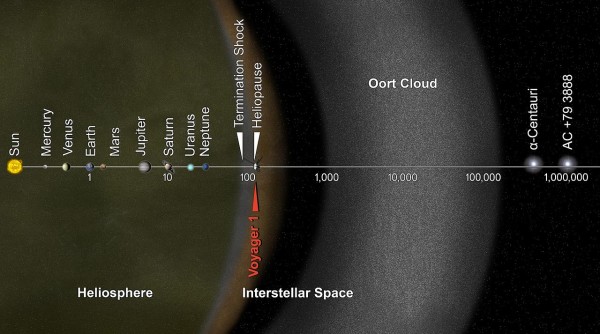 A logarithmic chart of distances, showing the Voyager spacecraft, our Solar System and our nearest star, for comparison. Image credit: NASA / JPL-Caltech.
A logarithmic chart of distances, showing the Voyager spacecraft, our Solar System and our nearest star, for comparison. Image credit: NASA / JPL-Caltech.
From Michael Kelsey on predicting the laser sail's demise from collisions: "With an average interstellar density of a few atoms per cubic centimeter (1e-4 in hot, ionized regions to 1e+6 in molecular clouds), a solar sail with an area of 1 km2 at 0.2 c will see a flux of something like 6e+16 impacts per second, or a heat load of 192 kW."
This is the main part of your estimation I'm unsure of. Your density numbers look good, your area looks good and your speed looks good. But impacts? I'm thinking of the famous Rutherford experiment, and the fact that if most of what we're likely to encounter is ionized rather than neutral (and bound), most of these particles will simply pass through this thin sail with no collision at all. In other words, the number of impacts and the heat load may be many orders of magnitude lower than your estimate.
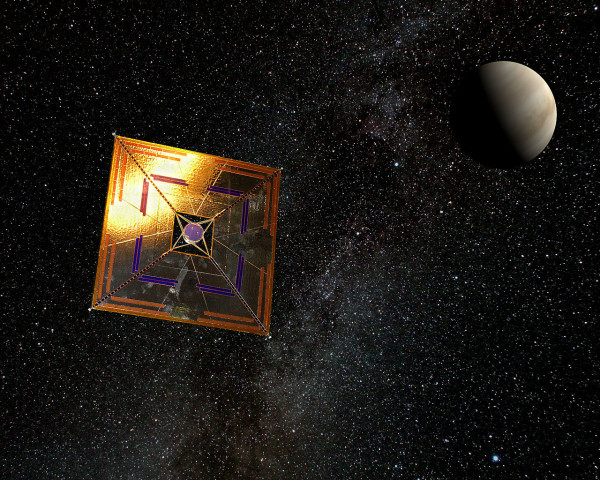 The concept art of a solar sail (Japan’s IKAROS project) at a distant planet or star system. Image credit: Andrzej Mirecki of Wikimedia Commons, under a c.c.a.-s.a.-3.0 license.
The concept art of a solar sail (Japan’s IKAROS project) at a distant planet or star system. Image credit: Andrzej Mirecki of Wikimedia Commons, under a c.c.a.-s.a.-3.0 license.
But I do wholeheartedly agree that each impact that does occur will not only be catastrophic as far as ionization (or even nuclear dissociation) goes, but a good fraction will conceivably result in e+/e- pair production as well. This is not necessarily going to be a happy, intact sail upon arrival is what I'm saying.
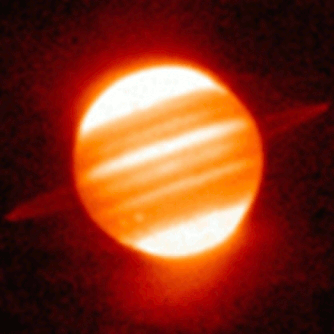 Jupiter and its rings, bands and other heat-sensitive features in the infrared. Image credit: user Trocche100 at the Italian Wikipedia.
Jupiter and its rings, bands and other heat-sensitive features in the infrared. Image credit: user Trocche100 at the Italian Wikipedia.
From eric on the rings of the gas giants: "I am also amazed that the structures remaining after the ~5 billion years our solar system has been around, are structures that would be stable for >=5 billion years. What an amazing, miraculous coincidence. Oh celestial mechanics, you trickster you!"
There are a couple of important points to highlight: a fraction of the ringed systems present us with rings that appear to be truly stable, as they may exist for the remainder of the Solar System, while others require creation and shepherding by moons. The outer rings of Saturn -- created by Enceladus and Phoebe -- are of the latter type, as are the rings of Jupiter and Neptune. The main rings of Saturn, as well as the majority of Uranus' rings, may be of the more stable type.
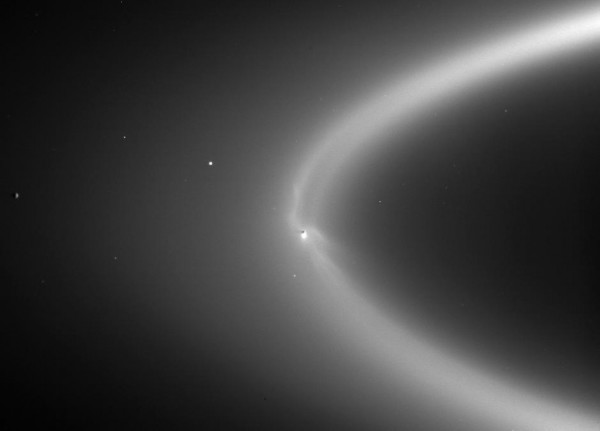 Image credit: NASA/JPL/Space Science Institute, of Saturn’s E-ring, with Enceladus as the brightest spot.
Image credit: NASA/JPL/Space Science Institute, of Saturn’s E-ring, with Enceladus as the brightest spot.
But, as Denier and Michael Kelsey rightly point out, that doesn't mean it's easy to determine whether Saturn's rings are ~100 million years old, ~4.5 billion years old, any number in between, or whether these are even the first incarnation of rings around it. As we all need to remember, there are many things that erase the early history of our Solar System, and now that we're finally here, all we can see are the survivors.
From Denier on the strong force: "Are the Color Force and the Strong Nuclear Force the same thing?"
Although there is a good discussion that follows Denier's comment led by Michael Kelsey, I'd like to chime in a little bit as well here. The strong nuclear force is one of the fundamental forces, and it comes in two manifestations:
- the binding force that holds mesons and baryons together through quark-gluon (or antiquark-gluon) interactions, and
- the binding force that holds atomic nuclei together, through (virtual) meson interactions.
Color force is an analogy to help us visualize this. If we allow quarks to be colored red, green or blue, and antiquarks to be colored cyan, magenta and yellow, then we can arrive at a colorless combination by having either a quark-antiquark combo or a 3-quark/3-antiquark combo. (Or superpositions of those: 1-quark/4-antiquarks, 2-quarks/2-antiquarks, 6-quarks, etc.)
You might imagine, from this, that there are six gluons, but in fact there are eight. (Because 3^2-1=8, which is a property of SU(3).) And while asymptotic freedom tells us that the strong force goes to zero at very short distances, it also goes to zero as soon as you begin moving away from a color-neutral entity. (I believe, IIRC, it scales as 1/r^6, which is why the strong nuclear force dies off so fast and we can't have very large nuclei for long.) I wrote a longer piece on this a while ago called The Strong Force For Beginners that goes over some of this in more detail, that you may enjoy.
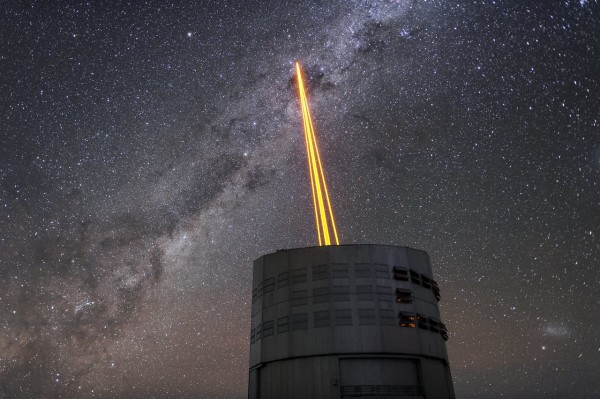 The four beams emerging from the new laser system on Unit Telescope 4 of the VLT. Image credit: ESO/F. Kamphues.
The four beams emerging from the new laser system on Unit Telescope 4 of the VLT. Image credit: ESO/F. Kamphues.
From Omega Centauri on guide stars, delays and adaptive optics: "Now how does the detector/computer combo, know which portions are delayed/advanced, from only looking at one image (unless its actually measuring the arrival time from a concentrated pule -which I really really doubt is possible)? Or is it just trying a bunch of perturbations and seeing what happens, or is their something really clever going on?"
The wonderful thing about light is that it always moves at the speed of light, so if you delay the light's arrival time by a certain, known amount, you know exactly how much "behind" your moving mirror is the actual light. Take a close look at the snapshot below.
There's a copy of the light being sent along the red path, while a fraction of the incoming light arrives at the purple path (at the bottom), telling us what the atmospheric distortion was at that moment. By time that red light arrives at the orange "distortion-removal" mirror, the purple signal has told the mirror what shape to be in to do the adaptation. As the next wavefront comes in, the mirror has adapted again. This adaptation is continuous and interpolated, and therefore imperfect, which is part of the inherent limitation of the technique. But the results are still amazing, and it kind of is like undistorting one snapshot at a time!
The effects of the Earth’s Atmosphere on the Telescopic Image of alpha Piscium from Edinburgh and from Alta Vista 10,700 ft., compared. From a 1863 engraving by Charles Piazzi Smyth, in the public domain.
From PJ on AO and giant telescopes for amateurs: "The best thing about the technology is that it will soon be possible for the backyard operator to run a similar setup in small scale. A 36 to 40 inch reflector in a dome is not out of the question in the near future. The cost of sodium lasers will eventually drop with demand. Quite a challenge, methinks."
I hate to say it, but "amateurs" have had ~24" telescopes at their disposal since the late 1800s, which is how Isaac Roberts took the very first picture of a galaxy beyond our own.
 Image credit: Isaac Roberts, from A Selection of Photographs of Stars, Star-clusters and Nebulae, Volume II, The Universal Press, London, 1899.
Image credit: Isaac Roberts, from A Selection of Photographs of Stars, Star-clusters and Nebulae, Volume II, The Universal Press, London, 1899.
The powerful sodium laser isn't the most expensive part, either; the adaptive mirror is. If you can get your hands on that, the software is free, and the rest is up to you to put the whole configuration together. Jim Misti and Adam Block are two of the more famous astrophotographers I admire, and their "amateur" status is a testament to how much one can do with off-the-shelf technology!
From See Noevo on the speed of gravity equalling the speed of light: "Must have been a slow news day in science."
Some days, you report the news by talking about a new discovery (or new hype); other days, you make the news by talking about something that is known by the experts, but by bringing it to a level that non-experts can understand. Science is always happening, but science communication only happens as science communicators choose it. Hopefully you enjoyed learning about this!
From Veri Tay on some blatantly untrue stuff: "Lol, gravity is instant, really all of modern so-called science is a bunch of lies. Primary light travels instantly – we see the universe in real-time."
It must have been fun to just make all these authoritative sounding statements without any facts or evidence to back them up. If everything is instantaneous, why are there time delays in the arrival of everything from gravitational wave pulses to the arrival of New Horizons' data from beyond Pluto to signals sent to-and-from the Moon.
And finally, from Naked Bunny with a whip on inhomogeneities: "I can safely say the water in my glass is of a uniform average density, even though most of the mass is concentrated into tiny nucleons surrounded by relatively vast stretches of space, and there are doubtless small temperature variations."
One of my favorite analogies to use for the level of inhomogeneity in the Universe -- and you can find this in my book -- is the surface of the ocean. If you imagine the ocean, some 3 miles (5 km) deep, and surface level waves maybe 1-10 cm in magnitude, the differences between the peaks and troughs relative to the entire depth of the ocean is similar to the initial differences between overdense and underdense regions in the Universe.
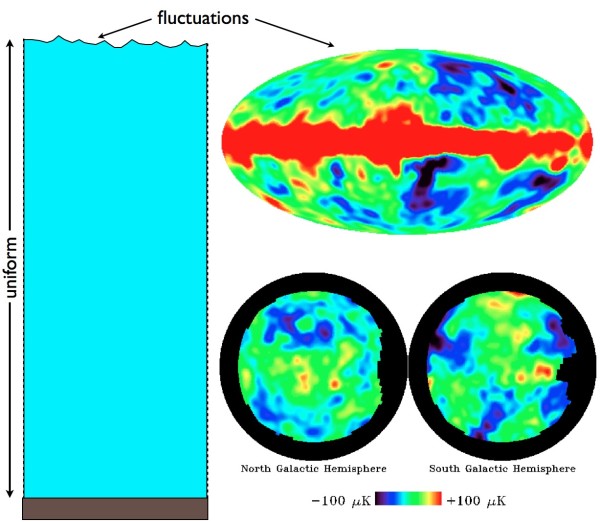 Fluctuations in the ocean relative to fluctuations in the density of the Universe. Images credit: E. Siegel and the COBE satellite/NASA.
Fluctuations in the ocean relative to fluctuations in the density of the Universe. Images credit: E. Siegel and the COBE satellite/NASA.
Over time, however, small scales have more time to gravitationally collapse, meaning we get greater density fluctuations on smaller scales today and smaller fluctuations, or smaller departures from the initial fluctuations, on the larger scales. That's what we've got, and that's consistent with what we expect!
Thanks for a great week, everyone, and I'll see you back here tomorrow for more wonders of the Universe, more stories, more science and more Starts With A Bang!
- Log in to post comments


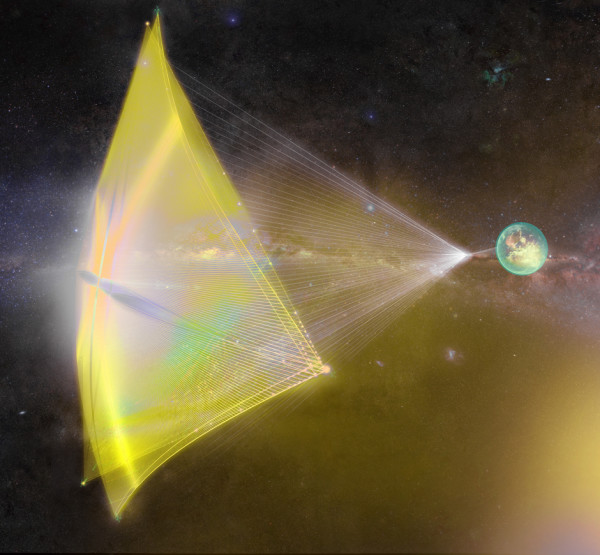

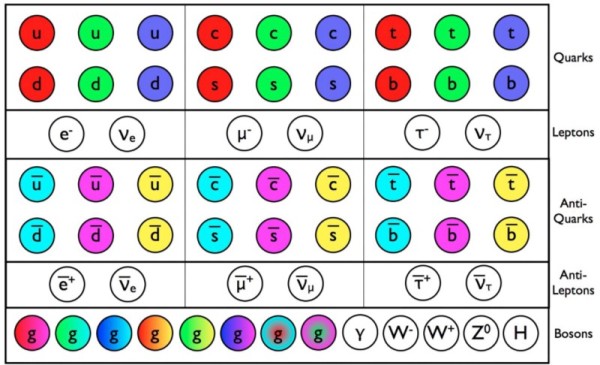
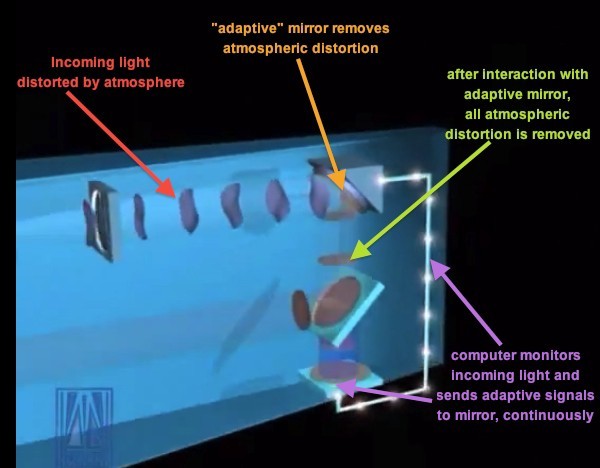
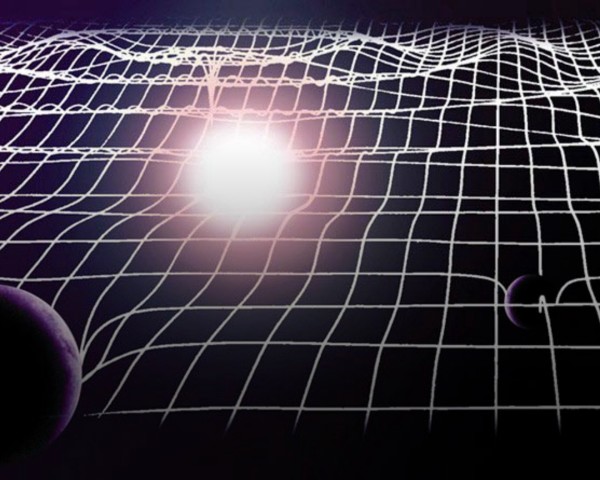
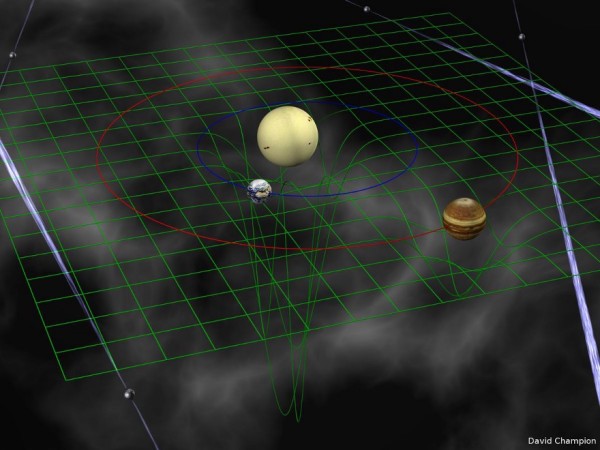
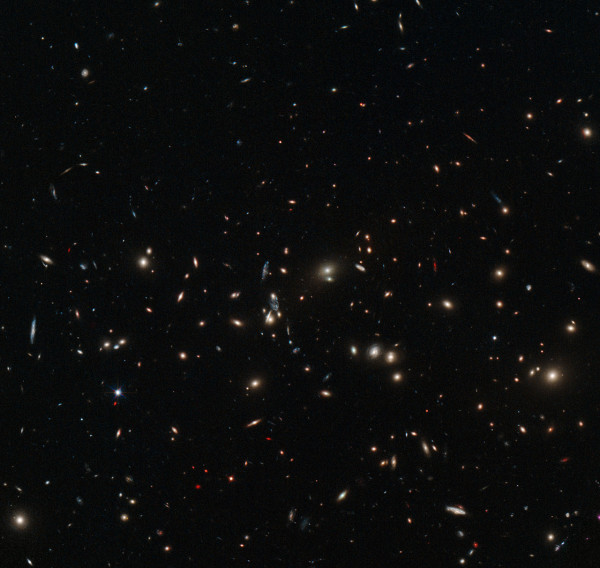
@Ethan, re collision rates on an interstellar sail. You're quite right about my estimate of collisions -- I did not include a cross-section value (probably something like a barn or so), which is important for a thin target like a solar sail. Let me go through what that looks like...
For something like graphene, the atoms are ~140 pm apart in a close-packed array, so each one is about 15,000 pm^2, or 150 Mb. With a nuclear cross-section of a few barns, my estimate was eight orders of magnitude too high.
But protons will see the whole atom via electromagnetic interactions, and the total ionization cross-section is as large as the whole atom (typically reported in units of 10^-16 cm^2, or 100 Mb), so this suggests that ionization (and hence some form of heating) will occur for nearly every collision.
Homogeneity is one of the necessary assumptions of Big Bang Theory.
Folks, take another look at Ethan’s images above of the “homogeneity” of the North and South Galactic Hemispheres.
Now, can you imagine looking into a glass of supposedly homogenized milk and seeing the very UN-homogeneous clumpiness of THOSE images?
What would you do?
I know what I’d do.
I’d throw it out.
And I’d say:
The universe is NOT homogeneous, on ANY scale.
Once again, go look at your milk through a 20,000× lens.
@SN
do you see the scale graph in the bottom right of that same image? The that says +/- 100 micro Kelvins.. do you know how small a micro Kelvin is?
“There are a couple of important points to highlight: a fraction of the ringed systems present us with rings that appear to be truly stable, as they may exist for the remainder of the Solar System, while others require creation and shepherding by moons.”
*Truly* stable?
Nothing in the universe is truly stable, in the long run.
On the other hand, *everything* in the universe, not just ringed systems,*does* require creation.
Speaking of which, you say
“The outer rings of Saturn — created by Enceladus and Phoebe — are of the latter type, as are the rings of Jupiter and Neptune.”
That sure sounds like a statement of fact, doesn't it? Something you *know*.
But I was wondering...
Enceladus is a mere 300 miles in diameter with 1/50,000th of Saturn’s mass. (Phoebe’s even smaller.)
How could such a teeny body as Enceladus spew all this stuff for billions of years? Where would it get the energy to carry on like this for billions of years?
Wiki seems to imply that even with tidal forces Enceladus spewing energy would give out in a teeny fraction of that time:
“Tidal dissipation of Enceladus's ice crust is significant because Enceladus has a subsurface ocean. Scientific models of heating on Enceladus suggest that despite the increased heat from tidal dissipation, the total observed heating of Enceladus is not enough to maintain a subsurface ocean for more than 30 million years (Enceladus is billions of years old)…”
.............
“But, as Denier and Michael Kelsey rightly point out, that doesn’t mean it’s easy to determine whether Saturn’s rings are ~100 million years old, ~4.5 billion years old, any number in between, or whether these are even the first incarnation of rings around it. As we all need to remember, there are many things that erase the early history of our Solar System, and now that we’re finally here, all we can see are the survivors.”
So, you haven’t determined whether the rings are “~100 million years old, ~4.5 billion years old, any number in between”,
yet you’re confident in the 13.8 billion year age of the Universe “to 99.1% accuracy, which is an amazing feat!”
As pointed out before, I would think that *you’d* think this was amazingly disturbing.
Because this would mean you might be off by 0.90%!
That’s over four times higher than what you said in another blog - ““false alarm probability” of 0.22% is actually quite high, for physics standards!”
Not that S.N. actually engages in "wondering" in the sense of original thought.
Ethan,
That’s a remarkable piece of what you call fanart. Your fan apparently sees you as some type of ...
fantasy creature – with human head, but walking on all fours, yet with cute little wings.
That poops rainbows! (Or is it a prismatic tail?)
Pure fantasy. I can see the link with Starts With A Bang!
……….
You’ve had a long week, Ethan.
And Sunday *is* supposed to be a day of rest.
So, I’ll leave you with some easy questions…
https://www.youtube.com/watch?v=qupeVLtXWLY
re AO, my comments were related to technology today, rather than the older methods of mirror manufacture. I have produced several 16 and 24 inch mirrors in my time, but thin plate adaptive optics becomes a different challenge. I'm not one to go out and buy 'off the shelf' goods when the enjoyment of creating for ones self is present.
WRT the 'chicken & the egg' comment, in your presentation, you suggest -
"Your best hope of deceleration, if you want your spacecraft to remain intact, is to have the same type of laser array waiting for you at your destination, ready to provide your spacecraft with the same frequency of light that accelerated it in the first place. "
:)
" Remind me of where you are in that progression again?"
Well, first tell me were we are in the progression of the end of the world cataclysmic flooding, starvation, wars, hurricanes, tornados, ect..ect that is blamed on "globull warming"?
But... anywho... lets start at step one:
"What you call “tampering” is what scientists call “adjustments”.
OK then please acknowledge that those with authority to make "adjustments" could b e tempted to slight adjustments to further their own agenda.
Such as OH now that there is a road here near our thermometer station we will disregard a local heat island effect and use that temp as a macro instead of a micro with representation or should I say mis-representation of reality to further the agenda.
Surly you trust Scientific American on at least the potential?
" An Epidemic of False Claims
Competition and conflicts of interest distort too many medical findings"
http://www.scientificamerican.com/article/an-epidemic-of-false-claims/